With the souping use of industrial cable glands in multiple markets, a ray of high fortune is marked in the cable gland industry across the globe. Be it a heavy duty equipment or a machinery, cable glands are used to provide strain relief from the flames, fire and heat. It is also known as connectors or cable fittings which are used to attach the cables with the devices or machines that has a secured base for cable armor that protects it from critical environments and hazardous areas. It has its application in all the automated instruments and electrical systems used in production, fabrication, data management, telecommunication, power generation and other controlling mechanics. With different purposes of customers to use the brass cable glands, the name of the game is selecting the right type and material of the cable glands that well suits the climatic reactions. In recent times, the industrial cable glands are being manufactured after proper planning with forecasting the future needs of domestic as well as international customers in addition to the fabrications in compliance with the international quality standards. This article drives you to the basics of industrial cable glands with insights into the material used in it and how selection of inputs used in cable glands is at the rim of the basket for the manufacturers as well as the OEM’s, new startups and other developing units in the market.
With the offset of 1950, the global market was dwelling upon the developments and discoveries in electrical connection and termination solution of wires and cables with the need for a quick reaction to growing use of energy. Breaking new grounds with varied customized layouts, the use of cable glands gradually showed a boost.
About industrial cable glands
The purpose to connect cables into industrial enclosures to retain the cables and protect them with a climate proof seal, cable gland became a player in the electronic market with a wide usage in the industrial units and corporate businesses. In present times, the shooting technological development in electronics and instrumentation systems has marked vital growth in use of cable glands to stay leery of uncertain temperature fluctuations and other dangers. The cable fittings and cable connectors are manufactured in different sizes, thickness and in varied material melds offered in the market with high end customization as per the major leagues for maintaining safety in corporate projects or assignments. They are available in the high range with varied sealing compound and thread types which includes metric cable glands, A2 cable glands, double compression cable glands, plastic cable glands, brass cable gland, metal cable gland and many more electrical cable glands.
Each and every cable gland type has its merits to refuge the electrical devices from dangers. They are rich in features with resistance to ozone, oil, UV, shore hardness and temperature fluctuations. To reduce the number of blueprints and have flexibility with ease in availability of component parts, metric cable glands are high in fashion. Non-armored cable glands are favorable for indoor and outdoor use, which has flexible use of compounds as per the purpose and requirement. This flexibility can be seen with installing plastic and elastomer in conduit or with the cables, having inner/outer cable sheath at both the sealing ends, cables with cold flow features and other varied types of metric cable gland.
Its application and selection of materials
For the fire safety solutions that suits all types of environmental conditions, cable gland has its applications in Marine, Industrial (explosive and non- explosive purpose), construction (MRT systems, corporate offices, shopping malls, airports, and stadiums), railway systems, metro systems, refineries, chemical industry and oil and gas units. Apart from these, the cable glands do have its applications in food and sanitation industry with high usage of polyamide threaded couplings with flat or multi cable fittings.
With the cable glands, there are many advanced installation accessories introduced in the market to take an extra step towards safety in critical projects. Some of which are Lock-nuts, Locks made of stainless steel, brass, polyamide and other material melds. In addition to this, other accessories include Sealing washer for protection at the cable enclosures, earth tags, serrated washers, Gland Spanners, Braid snips and many more as required for the project.
Depending on the needs of the customers, sensitivity, criticality of the project and flip/flops in the climate, the material melds are selected keeping in mind the size of gland and other electrical accessories that are to be used for installation. Whether it is cable with or without armor, metallic/ non metallic or a blend of both, metric cables, etc… the cable types are decided keeping in mind the material capacity to resist fire for a specific time period. For instance, cables with polyamide compounds are used for projects which needs to emit low Halogen and smoke. To get the characteristics of cold flow, thermoset material is used in soft bedded cables.
Thus, the essence of a successful project not only lies in the right selection of the inputs used, but also the quality and durability fall into the mainstream for the smooth and secured functioning of the instruments and electrical systems keeping them intact from dangerous. At last, the echo friendly cable glands are now becoming an add on to the prime concern for equipment safety as well as for a secured human life.
For more details, visit https://www.bicccomponents.uk.com/industrial-cable-glands/
 SUBSCRIBE TO OUR BLOG
SUBSCRIBE TO OUR BLOG
